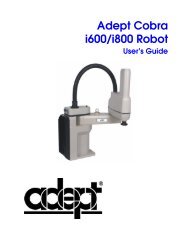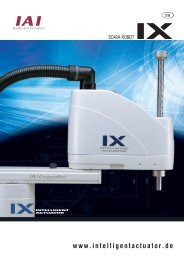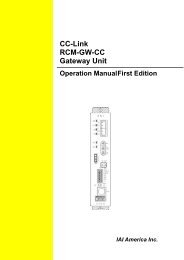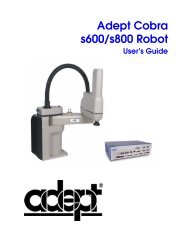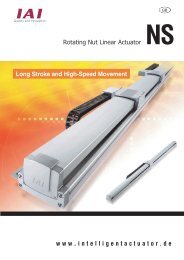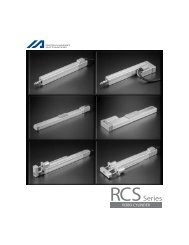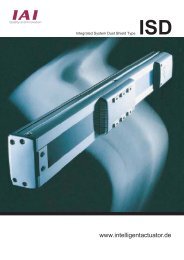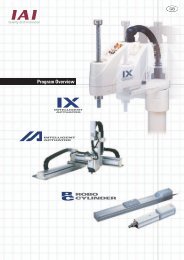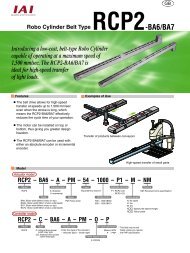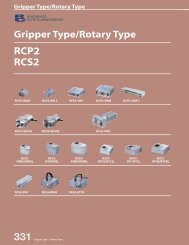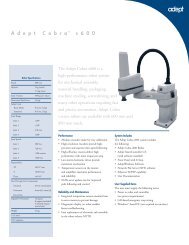Download Adept Cobra PLC600 User's Guide - pulsar.com.tr
Download Adept Cobra PLC600 User's Guide - pulsar.com.tr
Download Adept Cobra PLC600 User's Guide - pulsar.com.tr
Create successful ePaper yourself
Turn your PDF publications into a flip-book with our unique Google optimized e-Paper software.
In<strong>tr</strong>oduction 1<br />
1.1 Product Description<br />
The <s<strong>tr</strong>ong>Adept</s<strong>tr</strong>ong> <s<strong>tr</strong>ong>Cobra</s<strong>tr</strong>ong> PLC Robot system consists of a customer-supplied PLC, an <s<strong>tr</strong>ong>Adept</s<strong>tr</strong>ong> PLC<br />
Server, and an <s<strong>tr</strong>ong>Adept</s<strong>tr</strong>ong> <s<strong>tr</strong>ong>Cobra</s<strong>tr</strong>ong> <s<strong>tr</strong>ong>PLC600</s<strong>tr</strong>ong> or PLC800 robot. This manual covers the installation,<br />
operation, and maintenance of the <s<strong>tr</strong>ong>Adept</s<strong>tr</strong>ong> <s<strong>tr</strong>ong>Cobra</s<strong>tr</strong>ong> <s<strong>tr</strong>ong>PLC600</s<strong>tr</strong>ong>/PLC800 robot system, and<br />
describes the PLC Server software.<br />
Customer-Supplied PLC<br />
The customer-supplied PLC is used to <s<strong>tr</strong>ong>com</s<strong>tr</strong>ong>mand and con<strong>tr</strong>ol the robot. (The PLC may<br />
also be used to con<strong>tr</strong>ol other devices and processes in the workcell.) All application<br />
programs and location data are stored on the PLC. When the PLC application runs, the<br />
PLC writes <s<strong>tr</strong>ong>com</s<strong>tr</strong>ong>mand data to data files in the PLC, and the <s<strong>tr</strong>ong>Adept</s<strong>tr</strong>ong> PLC Server uses the<br />
DF1 Protocol to read those data files and to write status information to data files in the<br />
PLC.<br />
This product is <s<strong>tr</strong>ong>com</s<strong>tr</strong>ong>patible with the Allen-Bradley SLC, MicroLogix and Con<strong>tr</strong>olLogix<br />
product lines. The PLC must provide the following capabilities:<br />
1. An RS-232C serial port must be available for exclusive use by the PLC Server.<br />
2. The Float and S<strong>tr</strong>ing data types must be supported by the PLC.<br />
DF1 Protocol<br />
NOTE: The Allen-Bradley PLC5 family is not supported.<br />
DF1 Protocol is an Allen-Bradley serial protocol that is available on every Allen-Bradley<br />
PLC. It supports full-duplex (peer-to-peer) and half-duplex (master-slave)<br />
<s<strong>tr</strong>ong>com</s<strong>tr</strong>ong>munication, and is data <strong>tr</strong>ansparent. With the protocol, data <strong>tr</strong>ansmissions contain a<br />
16-bit CRC field to ensure data integrity. The maximum baud rate is 38.4 kps on most<br />
Allen-Bradley PLCs. DF1 is an “open” specification that has no licensing requirements. It<br />
is fully documented in Allen-Bradley publication 1770-6.5.16.<br />
<s<strong>tr</strong>ong>Adept</s<strong>tr</strong>ong> PLC Server<br />
The <s<strong>tr</strong>ong>Adept</s<strong>tr</strong>ong> PLC Server receives <s<strong>tr</strong>ong>com</s<strong>tr</strong>ong>mands from the PLC, interprets the information, and<br />
then <s<strong>tr</strong>ong>com</s<strong>tr</strong>ong>mands the robot to move. As the robot is <s<strong>tr</strong>ong>com</s<strong>tr</strong>ong>manded to move, status<br />
information is returned to the PLC.<br />
The <s<strong>tr</strong>ong>Adept</s<strong>tr</strong>ong> PLC Server also provides facilities to connect external E-Stop circui<strong>tr</strong>y to the<br />
system. A front panel with an E-Stop is included with the <s<strong>tr</strong>ong>Adept</s<strong>tr</strong>ong> PLC Server.<br />
<s<strong>tr</strong>ong>Adept</s<strong>tr</strong>ong> <s<strong>tr</strong>ong>Cobra</s<strong>tr</strong>ong> <s<strong>tr</strong>ong>PLC600</s<strong>tr</strong>ong>/PLC800 Robot User’s <s<strong>tr</strong>ong>Guide</s<strong>tr</strong>ong>, Rev B 15



